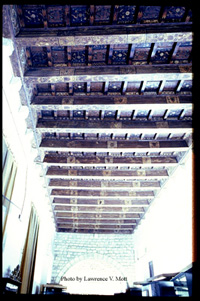
War of the Sicilian Vespers Homepage
Ships of the Fleet
The Catalan-Aragonese fleet used a variety of vessels to carry out a myriad of
tasks for the office of the admiral.  Each type of ship played an important role in the fleet, from combat scouting, to anti-piracy patrols, to the transport of amphibious
units or supplies. An actual snap shot of the fleet exists on the ceiling
of the Palace of the Marquès de Llió (right) in Barcelona. The ceiling of the great hall
was constructed sometime in the last quarter of the 13th century and has
painted on it the various types of ships in the Catalan fleet.
Each type of ship played an important role in the fleet, from combat scouting, to anti-piracy patrols, to the transport of amphibious
units or supplies. An actual snap shot of the fleet exists on the ceiling
of the Palace of the Marquès de Llió (right) in Barcelona. The ceiling of the great hall
was constructed sometime in the last quarter of the 13th century and has
painted on it the various types of ships in the Catalan fleet.
During the war, the Catalan-Aragonese fleet in Sicily normally mustered only 20
or so galleys for the sailing season. The actual types of galleys deployed
depended on whether the fleet was being lined out for naval combat or
amphibious operations. Below are pictures of the ship types from the
ceiling of the Palace of the Marquès de Llió with a short description of
the vessel and its function within the fleet. Note: Rollover images for more information.

Depiction of a
120 oared galley, or
galea grossa, which was the largest type deployed
by the fleet. Unlike their opponents, these galleys had raised forecastles and poops
from which the dreaded Catalan crossbowmen could shoot down on their
adversaries. The admiral's galley was traditionally painted red.

A painted tablita of a standard
galea for Mediterranean fleets. This type
of vessel had only a low forecastle and carried between 104 and 112 oars,
108 oared vessels being the most common. These were the workhorses of the
fleet and were used for virtually every type of duty.

This painting is probably of a
galion,
which was a type of light galley used
for a variety of duties. They varied widely in size, ranging from 36 to 84
oars and lacked any form of protective forecastle. They were primarily
used scouting, commerce raiding and for anti-piracy duty. Unlike the
standard galleys, they carried only a small contingent of crossbowmen or
marines.

A depiction of a
leny, which was a oared merchant vessel frequently pressed
into service by the fleet and used like galions. They were broader in the
beam and had to be reinforced for fleet duty. This vessel lacks the
typical rostrum of the warships (see above photos), which prevent the bow
from being crushed in when it came in contact with an enemy vessel. These
were not waterline rams.
 Sagetia
Sagetia
or
vaccetta was small armed galley used primarily for sending
messages and scouting. They were relatively small, carrying only
between 14 and 28 oars. Though small, they were seaworthy and were the
preferred vessel for pirates and
anti-piracy patrols alike. This tablita and the one above are currently in
the
Museu Nacional d'Art de Catalunya.

Depiction
of a
tarida or possibly a
galea aperte per puppa.
Taridas were large merchant galleys with between 112 and 116 oars. They were used only for
the transport of troops or horses and never in combat. They had hatches in
the stern with gang planks that could be lowered on to the beach.
Chronicles report that mounted troops could ride directly out of the ship
onto to beach. The Catalans also employed a specialized form of horse
transport called
galea aperte per puppa, which were armed and could
be used as a typical galley in naval combat.

The
workhorse of the fleet was the
barca, which was a large boat or
ship's barge with 18 to 22 oars. These barges could be attached to a 120 oared galley or operate
alone. They were sometimes used for scouting, but mainly served to transport supplies, men or even siege
engines. Unlike the
vaccettae, they operated with the fleet or in
coast waters and were generally not sent on missions in the open sea.
 Each type of ship played an important role in the fleet, from combat scouting, to anti-piracy patrols, to the transport of amphibious
units or supplies. An actual snap shot of the fleet exists on the ceiling
of the Palace of the Marquès de Llió (right) in Barcelona. The ceiling of the great hall
was constructed sometime in the last quarter of the 13th century and has
painted on it the various types of ships in the Catalan fleet.
Each type of ship played an important role in the fleet, from combat scouting, to anti-piracy patrols, to the transport of amphibious
units or supplies. An actual snap shot of the fleet exists on the ceiling
of the Palace of the Marquès de Llió (right) in Barcelona. The ceiling of the great hall
was constructed sometime in the last quarter of the 13th century and has
painted on it the various types of ships in the Catalan fleet.
 Depiction of a
Depiction of a  A painted tablita of a standard
A painted tablita of a standard  This painting is probably of a
This painting is probably of a  A depiction of a
A depiction of a

 Depiction
of a
Depiction
of a  The
workhorse of the fleet was the
The
workhorse of the fleet was the 